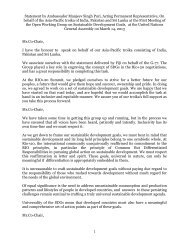STATE OF THE WORLD'S CITIES 2012/2013 Prosperity
STATE OF THE WORLD'S CITIES 2012/2013 Prosperity
STATE OF THE WORLD'S CITIES 2012/2013 Prosperity
Create successful ePaper yourself
Turn your PDF publications into a flip-book with our unique Google optimized e-Paper software.
State of the World’s Cities <strong>2012</strong>/<strong>2013</strong><br />
POLICy<br />
If left unaddressed, socioeconomic fragmentation can<br />
jeopardise urban prosperity and pose major risks to<br />
nationwide political stability.<br />
repeatedly and disproportionately refrained from taking<br />
their fair, full share of the multidimensional benefits of the<br />
‘urban advantage’, the above statement comes with two<br />
interconnected corollaries. First, inequality can be linked<br />
to poor economic productivity, and experience shows that<br />
more sustainable urban economies are frequently associated<br />
with lower inequality. Second, persistent, ever-higher<br />
inequality carries direct risks. Stark disparities within cities<br />
have proven to be social detonators, as recent revolutions<br />
in the Arab world and social unrest in some cities in the<br />
developed world have recently demonstrated.<br />
Take a city anywhere in the world that can boast<br />
sustained economic growth thanks to high productivity,<br />
adequate infrastructure, a high quality of life and<br />
environmental preservation: the more this prosperity is<br />
inequitably distributed, the more precarious it is bound<br />
to be. All five ‘spokes’ in the ‘prosperity wheel’ must be<br />
developed in a well-balanced way for a smoother ride on the<br />
path of sustainable, shared prosperity.<br />
The recent society-wide upheavals in Tunisia, Libya<br />
and Egypt did not occur against a background of extreme<br />
poverty or deprivation. In all three countries, national<br />
poverty reduction programmes had gained considerable<br />
traction. Slum improvement or eradication had been<br />
achieved or was on-going. Large infrastructure projects<br />
with adequate transport networks had been deployed or<br />
were underway and, in terms of education and health,<br />
achievements were approaching or surpassing national<br />
Millennium Development Goals. Still, Egypt, Libya and<br />
Tunisia were shown to have feet of clay. The sobering<br />
message from the Arab<br />
Spring, though still in a<br />
When prosperity state of flux, is that leaders<br />
POLICy remains an<br />
and societies ignore<br />
elusive proposition for a inequality at their own peril.<br />
majority of the population,<br />
A recent report on the<br />
the prospects of social<br />
East African Community<br />
unrest or full-blown<br />
has highlighted a number of<br />
conflicts increase, since<br />
the majority’s claims are remarkable achievements in<br />
nothing but demands for terms of economic growth<br />
effective human dignity. over the past decade,<br />
propelled by massive<br />
72<br />
increases in trade based on new, all-weather roads and uptake<br />
of mobile telephone technology. Still, the actual number of<br />
East Africans living below the poverty line has increased from<br />
44 million to 53 million, and income inequality indicators, as<br />
measured by Gini coefficients, have also worsened in most<br />
countries. 15 As a regional expert put it, ”The reason for this<br />
is that inequality is both deepening and widening. Fewer<br />
people are enjoying the benefits of economic growth.” 16<br />
Inequality and criminality appear to be part and parcel<br />
of the same equation. This is all the more so when lack of<br />
opportunities and rising unemployment are added to the<br />
balance. Perceptions of rising criminality, and the fears<br />
thereof, may be strong in cities characterised by high<br />
inequity, and even stronger than actual numbers actually<br />
state. In one poll, comparing perceptions and expert<br />
opinion in São Paulo and London, criminality emerged<br />
as a major concern in both cities, even though actual<br />
numbers in São Paulo were a multiple of London’s. 17 In<br />
the same survey, residents of cities as diverse as Mumbai,<br />
Chicago, Cairo, London, Paris, Beijing and São Paulo<br />
overwhelmingly agreed (89 per cent) that “a non-dangerous<br />
city” was their prime criterion for the ‘good urban life’, a<br />
notion that has much to do with prosperity.<br />
LINkING EQUITy TO PROSPERITy<br />
“Inequalities are increasing day after day”, according to a<br />
local expert in Hyderabad. This comment echoes findings<br />
from the United Nations General Assembly 2011 Report on<br />
Progress towards Millennium Development Goals (MDGs),<br />
which stressed that “despite advances towards achieving<br />
the MDGs, insufficient emphasis in the MDG agenda had<br />
been given to the issue of inequity which is increasing within<br />
and between countries.” 18 Even in those countries that have<br />
made progress towards the MDGs, inequalities have grown.<br />
Therefore, as suggested by the UN General Assembly, equity<br />
must be mainstreamed in the development agenda, based on<br />
more inclusive growth.<br />
Evidence showing that<br />
equity is a critical dimension<br />
of prosperity runs<br />
against the conventional<br />
development approaches<br />
that prevailed before the<br />
2008–09 global financial<br />
crisis. A particular case in<br />
point is the ‘Washington<br />
Consensus’, which<br />
reinforced the notion that<br />
POLICy<br />
Cities must<br />
pay more<br />
attention to inequity as<br />
a critical factor affecting<br />
prosperity. Deliberate<br />
and conscious policies<br />
now need to emphasise<br />
the importance of equity<br />
in urban decisionmaking.




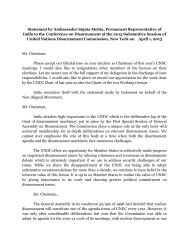
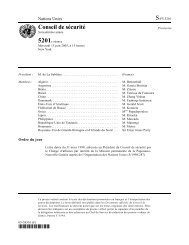
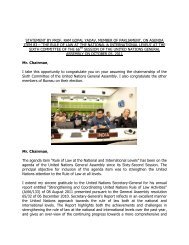

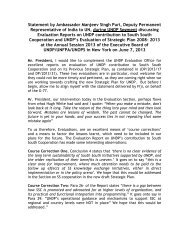
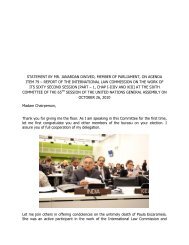
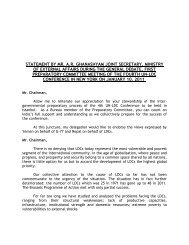
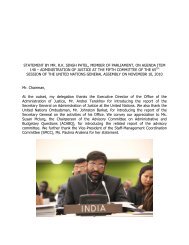

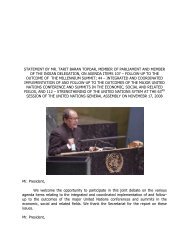
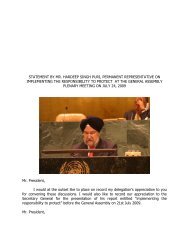
![1 statement by dr.[mrs] kakoli ghosh dastidar - Member States Portal](https://img.yumpu.com/27526598/1/190x245/1-statement-by-drmrs-kakoli-ghosh-dastidar-member-states-portal.jpg?quality=85)
